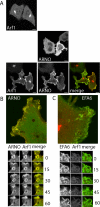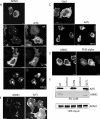Active Arf6 recruits ARNO/cytohesin GEFs to the PM by binding their PH domains
- PMID: 17409355
- PMCID: PMC1877112
- DOI: 10.1091/mbc.e06-11-0998
Active Arf6 recruits ARNO/cytohesin GEFs to the PM by binding their PH domains
Abstract
ARNO is a soluble guanine nucleotide exchange factor (GEF) for the Arf family of GTPases. Although in biochemical assays ARNO prefers Arf1 over Arf6 as a substrate, its localization in cells at the plasma membrane (PM) suggests an interaction with Arf6. In this study, we found that ARNO activated Arf1 in HeLa and COS-7 cells resulting in the recruitment of Arf1 on to dynamic PM ruffles. By contrast, Arf6 was activated less by ARNO than EFA6, a canonical Arf6 GEF. Remarkably, Arf6 in its GTP-bound form recruited ARNO to the PM and the two proteins could be immunoprecipitated. ARNO binding to Arf6 was not mediated through the catalytic Sec7 domain, but via the pleckstrin homology (PH) domain. Active Arf6 also bound the PH domain of Grp1, another ARNO family member. This interaction was direct and required both inositol phospholipids and GTP. We propose a model of sequential Arf activation at the PM whereby Arf6-GTP recruits ARNO family GEFs for further activation of other Arf isoforms.
Figures







Similar articles
-
Specificities for the small G proteins ARF1 and ARF6 of the guanine nucleotide exchange factors ARNO and EFA6.J Biol Chem. 2001 Jul 6;276(27):24925-30. doi: 10.1074/jbc.M103284200. Epub 2001 May 7. J Biol Chem. 2001. PMID: 11342560
-
ARL4D recruits cytohesin-2/ARNO to modulate actin remodeling.Mol Biol Cell. 2007 Nov;18(11):4420-37. doi: 10.1091/mbc.e07-02-0149. Epub 2007 Sep 5. Mol Biol Cell. 2007. PMID: 17804820 Free PMC article.
-
Kinetic studies of the Arf activator Arno on model membranes in the presence of Arf effectors suggest control by a positive feedback loop.J Biol Chem. 2011 Feb 4;286(5):3873-83. doi: 10.1074/jbc.M110.145532. Epub 2010 Nov 30. J Biol Chem. 2011. PMID: 21118813 Free PMC article.
-
Allosteric regulation of Arf GTPases and their GEFs at the membrane interface.Small GTPases. 2016 Oct;7(4):283-296. doi: 10.1080/21541248.2016.1215778. Epub 2016 Jul 22. Small GTPases. 2016. PMID: 27449855 Free PMC article. Review.
-
Arf GTPase regulation through cascade mechanisms and positive feedback loops.FEBS Lett. 2013 Jun 27;587(13):2028-35. doi: 10.1016/j.febslet.2013.05.015. Epub 2013 May 16. FEBS Lett. 2013. PMID: 23684643 Review.
Cited by
-
Shigella flexneri regulation of ARF6 activation during bacterial entry via an IpgD-mediated positive feedback loop.mBio. 2015 Mar 3;6(2):e02584. doi: 10.1128/mBio.02584-14. mBio. 2015. PMID: 25736891 Free PMC article.
-
Allosteric properties of PH domains in Arf regulatory proteins.Cell Logist. 2016 Apr 26;6(2):e1181700. doi: 10.1080/21592799.2016.1181700. eCollection 2016 Apr-Jun. Cell Logist. 2016. PMID: 27294009 Free PMC article. Review.
-
ADP ribosylation factor 6 (Arf6) acts through FilGAP protein to down-regulate Rac protein and regulates plasma membrane blebbing.J Biol Chem. 2014 Apr 4;289(14):9675-82. doi: 10.1074/jbc.M113.546051. Epub 2014 Feb 13. J Biol Chem. 2014. PMID: 24526684 Free PMC article.
-
Ancient complement and lineage-specific evolution of the Sec7 ARF GEF proteins in eukaryotes.Mol Biol Cell. 2019 Jul 15;30(15):1846-1863. doi: 10.1091/mbc.E19-01-0073. Epub 2019 May 29. Mol Biol Cell. 2019. PMID: 31141460 Free PMC article.
-
Rab4 orchestrates a small GTPase cascade for recruitment of adaptor proteins to early endosomes.Curr Biol. 2014 Jun 2;24(11):1187-98. doi: 10.1016/j.cub.2014.04.003. Epub 2014 May 15. Curr Biol. 2014. PMID: 24835460 Free PMC article.
References
-
- Antonny B., Beraud-Dufour S., Chardin P., Chabre M. N-terminal hydrophobic residues of the G-protein ADP-ribosylation factor-1 insert into membrane phospholipids upon GDP to GTP exchange. Biochemistry. 1997;36:4675–4684. - PubMed
-
- Balla T. Inositol-lipid binding motifs: signal integrators through protein-lipid and protein-protein interactions. J. Cell Sci. 2005;118:2093–2104. - PubMed
Publication types
MeSH terms
Substances
Grants and funding
LinkOut - more resources
Full Text Sources
Other Literature Sources

